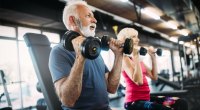A muscular body looks good and is often a goal for many weightlifters. Clothes look (and feel) better, and compliments from others are a constant confidence booster. Not to mention, looking and feeling strong is priceless.
However, the benefits of muscle mass reach beyond aesthetics. “Your resilience, your ability to ward off aging and age-related diseases resides in your muscle,” explains Dr. Brett Osborn, a Board-Certified Neurosurgeon with a secondary certification in Anti-Aging and Regenerative Medicine and the author of Get Serious.
And while you may already know that maintaining muscle mass helps burn fat, there are other benefits that will ensure your later years are stronger and safer.
From injury prevention to combating age-related diseases, Dr. Osborn, who has over 30 years of training experience and is a trained medical professional, shares just how important it is to keep lifting and strengthening your body as you age. Muscle Mass is the key to longevity, here’s why.
How Much Muscle Do You Lose as You Age?
The popular phrase, “If you don’t use it, you lose it” applies perfectly to age-related muscle loss, or what’s referred to as sarcopenia. In fact, you can lose up to three to five percent of your muscle mass per decade after the age of 30, Men alone can lose one-third of their muscle mass during their lifetime.
Although these stats are alarming, the reality is, you can preserve your muscle mass and walk confidently into your future if you stick to a regular strength training regimen. (And of course, practice a solid nutrition plan!).

The Benefits Muscle Mass Has on the Later Years of Life
Without question, when the body hosts adequate muscle mass as it ages, many downfalls will be avoided. Here, Dr. Osborn shares the vital benefits muscle mass provides to the human body and quality of life.
Lowers the Potential for Arterial Damage: Muscle is metabolically very important as muscle filters glucose out of the vascular system, thereby lessening any potential damage induced by high levels of circulating glucose. High levels of circulating glucose damage arterial walls, and
this damage is the catalyst for plaque formation. The glucose-lowering effect of muscle (by strength training in the glycolytic range) lowers the potential for arterial damage, therefore, less damage and less atherosclerotic disease.
Increases Bone Density, Reduces the Risk of Falling:
This corresponds to a decreased propensity for fracture, a major cause of morbidity in the senior population. “You want to run (literally) into your later years with as much muscle as possible,” says Dr. Osborn. In a similar context, “The more muscle on one’s frame typically corresponds to a reduced risk of fall; the most common cause of head injury in the senior population.”
Osborn spends many of his days performing brain surgery on individuals who suffered head injuries. Most of these injuries were a result of a falls due to lack of muscle, along with declining cognitive function. These two factors often go hand and hand. “Unfortunately, those who fail to exercise and, in particular, strength train, are not stimulating their brains,” says dr. Osborn. “Cognitive function and coordination falter and muscle mass wanes.”
However, those who exercise typically have more muscle on their frames, fall less, and have better-functioning brains with a reduced incidence of dementia.
Muscle Confers a Survival Benefit:
A 2008 study published in British Medical Journal, as cited in Dr. Osborne’s book, demonstrates a reduced incidence of all-cause mortality (including cancer) in stronger men relative to their weaker counterparts. And this was independent of cardiovascular fitness. “Survival of the fittest (or strongest)? Absolutely. It is well known that the act of “exercise” turns on over 100 genes that are associated with longevity,” says Dr. Osborne. Again, not shocking news here, the stronger do survive longer.
Boosts Fat Burning:
“The best way to burn fat off your body, contrary to popular opinion, is strength training,” Osborn explains. The amassment of muscle will increase one’s basal metabolic rate (BMR), the number of calories it takes to maintain your body as is – in a steady state. Simply put, the more muscle, the higher your BMR.
“Muscle is ‘metabolically expensive’—either you fuel it, or it will be shed,” Osborn explains. Muscle can derive calories from food that you eat or from bodily fat stores, particularly in the immediate wake of a heavy training session. Muscle burns fat off your waistline—meaning, yes, many of us can scrap the countless situps, according to Osborn.
Overall Injury Prevention:
“Strong abdominal muscles and muscle in general – when combined with flexibility – prevents injury,” says Dr. Osborn. “They facilitate the lifting and maneuvering of objects in awkward positions, in real-life situations.”
Have you ever helped a friend lift a sofa? If so, you know just how important it is to have a strong lower body and, in particular, a strong lower back.
“Similarly, the bracing effect of strong lumbar erectors and your abdominal wall will prevent you from getting injured and potentially from developing lower back pain,” says Dr. Osborn, who is also a powerlifter and holds the Florida state deadlifting record in the Master’s II division. “No low back pain. Get the picture?” he asks.
The Dangers of Lacking Muscle Mass
Now that you know the benefits of hosting solid muscle mass, it’s time to look at the downside of skimping out on strength training.
- Increased risk of injuries: Reduced muscle mass leads to decreased strength and stability, making individuals more susceptible to falls, fractures, and other injuries.
- Declining bone health: Loss of muscle mass can contribute to bone loss and osteoporosis, increasing the risk of fractures and compromising overall bone strength.
- Decreasing metabolic rate: Muscle is metabolically active tissue, and its loss can lead to a slower metabolism, making weight management more challenging and increasing the risk of weight gain.
- Impaired glucose regulation: Reduced muscle mass is associated with decreased insulin sensitivity (or insulin resistance), which can contribute to the development of type 2 diabetes and potentially atherosclerosis. Reiterating, the muscle acts as a “glucose filter.”
- Reduced functional capacity: Lack of muscle mass can result in reduced physical performance, decreased mobility, and difficulties with activities of daily living. Dr. Osborn asks, “Don’t you want to be able to keep up with your children and grandchildren?” We all do, and one thing that can support that goal to maintain
Strength training is the key to gaining and sustaining muscle mass. The secret to finding the best training program for you is choosing the one you enjoy doing while making sure it challenges and strengthens you consistently.
Here is a great strength training program option for you to give a try!
A Look at Dr. Osborne’s Training Program for Gaining Muscle at Any Age
Want to gain muscle no matter your age or current physical condition? Dr. Osborn encourages progressive resistance training, utilizing proper techniques, and explains this training method is the foundation of the program detailed in his book ‘Get Serious.’
PRO TIP: This training program is best paired with proper nutrition, adequate rest, sleep, and the avoidance of overtraining.

Monday’s Workout from the ‘Get Serious’ Protocol
- Remember to warm up thoroughly before training.
Workout Example 1
Overview: The bench press is the primary movement.
- Do 3 sets of 8 reps.
- If you complete all 25 reps, the weight amount is advanced when the bench press is again the primary movement (two weeks later).
- Rest between sets: 3-5 minutes.
- Your goal here is to better your last BENCH PRESS 5 x 5 performance.
Workout Example 2
Overview: The bench press will be followed by deadlifts.
- Do 3 sets of 8 reps.
- The weight is 90% of your last successful deadlift session (when deadlifts were the primary movement, one week prior).
- These sets are performed with 90-second rest intervals on the clock.
Workout Example 3
Overview: Auxiliary exercises are the focus.
- Choose one pair of movements and work them in a 3×8 scheme.
- Do 3 sets of 8 reps.
- These are not supersets but are done sequentially. (3×8, then 3×8).
- These movements do not need to be taken to failure but should be taxing—Rate of Perceived Exertion (RPE): 8 on all sets.
NOTE: The program in “Get Serious” is a back-to-basics approach utilizing heavy, compound anabolic movements that tax the most muscle in the shortest period of time. These movements: squat, bench press, deadlift, overhead press, and a pull/chin-up—have made men and women strong for eons. People nowadays tend to gravitate to machine-based training or WOD-type protocols when they should truly be sticking to properly performed basic movements that load the musculoskeletal system and are not rooted in racing or competition. Bang for the buck, there is nothing better.


Comments are closed.